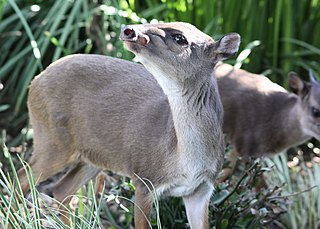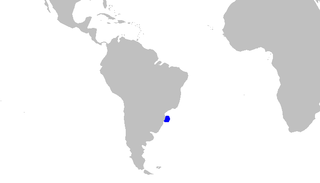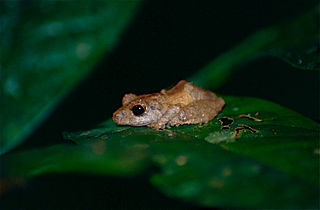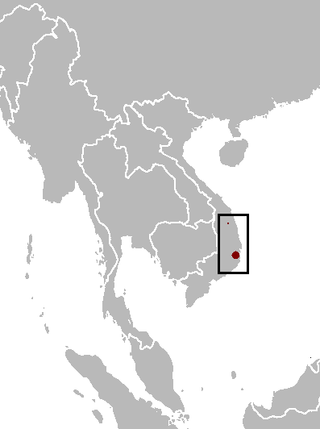
Coral snakes are a large group of elapid snakes that can be divided into two distinct groups, the Old World coral snakes and New World coral snakes. There are 27 species of Old World coral snakes, in three genera, and 83 recognized species of New World coral snakes, in two genera. Genetic studies have found that the most basal lineages have origins in Asia, suggesting that the group originated in the Old World. While new world species of both genera are venomous, their bites are seldom lethal; only two confirmed fatalities have been documented in the past 100 years from the genus Micrurus. Meanwhile, snakes of the genus Micruroides have never caused a medically significant bite.

Micrurus is a genus of venomous coral snakes of the family Elapidae.

The blue duiker is a small antelope found in central, southern and eastern Africa. It is the smallest species of duiker. The species was first described by Swedish naturalist Carl Peter Thunberg in 1789. 12 subspecies are identified. The blue duiker reaches 32–41 centimetres (13–16 in) at the shoulder and weighs 3.5–9 kilograms (7.7–19.8 lb). Sexually dimorphic, the females are slightly larger than the males. The dark tail measures slightly above 10 centimetres (3.9 in). It has short, spiky horns, around 5 centimetres (2.0 in) long and hidden in hair tufts. The subspecies show a great degree of variation in their colouration. The blue duiker bears a significant resemblance to Maxwell's duiker.

Micrurus tener, commonly known as the Texas coral snake, is a species of venomous snake in the family Elapidae. The species is native to the southern United States and adjacent northeastern and central Mexico. Six subspecies are recognized as being valid, including the nominotypical subspecies, Micrurus tener tener The species Micrurus tener was once considered to be a subspecies of the eastern coral snake.

The dark shyshark or pretty happy is a species of catshark, belonging to the family Scyliorhinidae, endemic to the temperate waters off southern Namibia and western South Africa. It is benthic in nature and inhabits shallow, inshore waters and favors rocky reefs and kelp forests. Growing to 60 cm (24 in) long, this small, stocky shark has a wide, flattened head with a rounded snout and a large flap of skin extending from before the nostrils to the mouth. Its dorsal coloration is extremely variable and may feature black-edged orange to blackish saddles and/or white spots on a light brown to nearly black background.

The southern sawtail catshark is a species of catshark, part of the family Scyliorhinidae, endemic to southern Brazil. It inhabits deepwater reefs on the upper continental slope at a depth of 236–600 m (774–1,969 ft). Reaching at least 43 cm (17 in) in length, this slim-bodied species closely resembles the Antilles catshark. It has a prominent crest of enlarged dermal denticles along the dorsal edge of the caudal fin, as well as a distinctive color pattern of dark oval blotches, outlined in white, along its back. The southern sawtail catshark is oviparous, with females producing reddish egg capsules. The International Union for Conservation of Nature (IUCN) has assessed it as Vulnerable; it is often taken as bycatch and may be threatened by intensifying squid fishing.

The ringed kingfisher is a large, conspicuous, and noisy kingfisher bird commonly found along the lower Rio Grande Valley in southeasternmost Texas in the United States through Central America to Tierra del Fuego in South America.

Micrurus hemprichii, commonly known as Hemprich's coral snake and the worm-eating coral snake, is a species of venomous coral snake in the family Elapidae. The species is native to South America.
The Macedonian mouse is a species of rodent in the family Muridae and order Rodentia. This rodent lives in the area from eastern Georgia and western Bulgaria to Israel. It is considered part of a Palearctic group along with three other species: the house mouse, steppe mouse, and Algerian mouse.

Pristimantis inguinalis is a species of frog in the family Strabomantidae. It is found in Guyana, Suriname, French Guiana, and northern Brazil. The type locality is New River, in the disputed area claimed by both Guyana and Suriname. Common names New River robber frog and New River South American rain frog have been coined for it.
Pristimantis variabilis is a species of frog in the family Strabomantidae. It is found in the lowland Amazon rainforest and Andean slopes in southern Colombia, eastern Ecuador, eastern Peru, and western Brazil. The specific name variabilis refers to the variable dorsal coloration of this frog. Common name variable robber frog has been proposed for it.

The bronze-winged courser or violet-tipped courser is a species of bird in the family Glareolidae. This species is named for its characteristic bronze-tipped feathers that are visible during flight. It is found living throughout Sub-Saharan Africa, inhabiting semi-arid savannas and woodlands. This is a nocturnal species which mainly feeds on ground-dwelling insects. Bronze-winged coursers are typically solitary, only forming monogamous pairs for breeding. A female may produce 2-3 eggs per clutch, and the chicks receive parental care from both sexes when young. The bronze-winged courser is considered of Least Concern for conservation status, and is thought to be a very stable species.

The Vietnam mouse-deer, also known as the silver-backed chevrotain, is an even-toed ungulate in the family Tragulidae known only from Vietnam. It was first described in 1910 by British zoologist Oldfield Thomas, who procured four specimens from Nha Trang in Annam. Little is known about its distribution and ecology. After 1910, the Vietnam mouse-deer was reported next in 1990 near Dak Rong and Buon Luoi in the Gia Lai Province. With increasing hunting pressure, habitat loss due to deforestation and no more reports of the species in the wild, the mouse-deer was feared to have gone extinct. The IUCN listed the species as Data Deficient in 2008. In 2019, a study confirmed the presence of the Vietnam mouse-deer in dry low-lying forests of southern Vietnam with camera trap evidence. The mouse-deer is characterised by a rough coat with a strange double-tone coloration unseen in other chevrotains; the front part of the body is reddish brown and contrasts strongly with the greyish posterior. It has big reddish brown ears, white and dark reddish brown marks on the throat.

Micrurus lemniscatus, commonly known as the South American coral snake, is a species of venomous snake in the family Elapidae. The species is endemic to South America.

Micrurus annellatus, commonly known as annellated coral snake, is a species of venomous elapid snake native to southeastern Ecuador, eastern Peru, Bolivia, and western Brazil. There are three recognized subspecies, including the nominate subspecies described here.

Micrurus corallinus is a species of highly venomous elapid snake native to South America. There are no recognized subspecies.

Coryphellina rubrolineata is a species of sea slug, an aeolid nudibranch, a marine heterobranch mollusc in the family Flabellinidae.

Micrurus mipartitus is a species of coral snake in the family Elapidae. The species is native to Central America and northern South America. The red-tailed coral snake is common in agricultural areas in Colombia. Its highly neurotoxic venom is known to cause seizures in its prey by activating nerve proteins responsible for seizures within it.

Micrurus diana, also known commonly as Diana's coral snake, is a species of venomous snake in the family Elapidae. The species is native to South America.
Micrurus helleri, also known commonly as Heller's coral snake and the western ribbon coral snake, is a species of venomous snake in the family Elapidae. The species is native to South America.
















